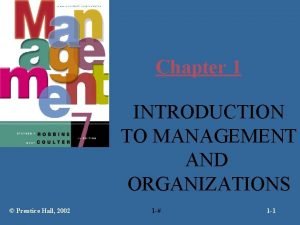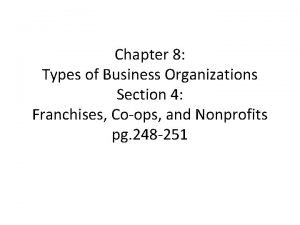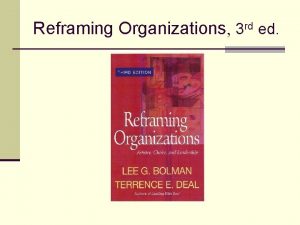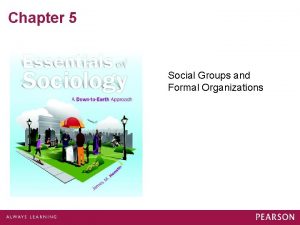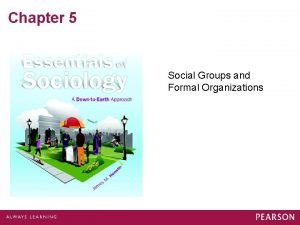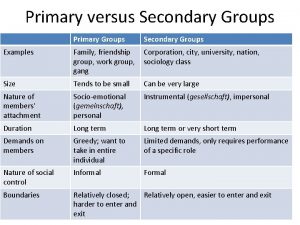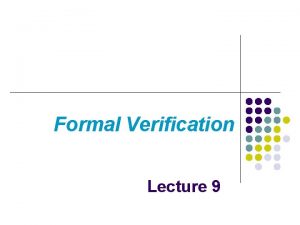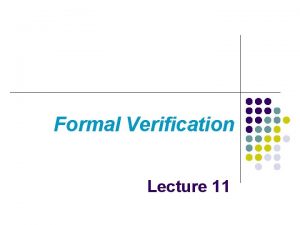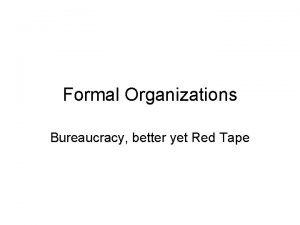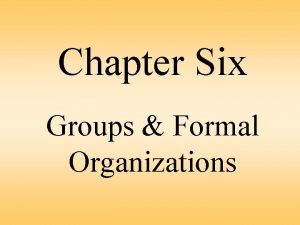Groups and Formal Organizations CHAPTER 6 Primary Groups

























- Slides: 25

Groups and Formal Organizations CHAPTER 6

Primary Groups and Secondary Groups Group: at least two people who have one or more goals in common and share common ways of thinking and behaving • they are in regular contact with one another • they share ways of thinking, feeling, and behaving • they take one another’s behavior into account • they have one or more interests or goals in common

Neither Social Categories nor Social Aggregates are considered to be groups Social Category: people who share a social characteristic • • • women teenagers elderly citizens of a town Social Aggregate: people who happen to be in the same place at the same time • people waiting in line for movie tickets • people waiting for a bus • people attending a concert • witnesses of an accident

Primary Groups Primary Group: people who are emotionally close, know one another well, and seek one another’s company • family • close friends Primary Relationships: interactions that are intimate, personal, caring, and fulfilling

How Do Primary Groups Develop? What conditions favor their formation? • small size • face-to-face contact • continuous contact • proper social environment

What are the functions of primary groups? They provide three important functions in society • emotional support • socialization • encourage conformity

Secondary Groups Secondary Group: people who share only part of their lives while focusing on a goal or task Secondary Relationships: impersonal relationships involving limited parts of relationships

Other Groups and Networks… Reference Groups Reference Group: group used for self-evaluation and the formation of attitudes, values, beliefs, and norms

In-Groups and Out-Groups Like two sides of a coin…you can’t have one without the other In-Group: exclusive group demanding intense loyalty (cliques) Out-Group: group targeted by in-group for opposition, antagonism, or competition jocks, cheerleaders, etc. nerds are in-groups for some, out-groups for others Freaks and Geeks

How are Group Boundaries Maintained? Boundaries

Social Networks Social Network: a web of social relationships that join a person to other people and groups Small World

Five Types of Social Interaction 1. Cooperation: individuals and groups combine their efforts to reach a goal Barn Raising

2. Conflict : interaction aimed at defeating an opponent argument

3. Social Exchange: a voluntary action performed in the expectation of getting a reward in return Sesame Street

4. Coercion: individuals or groups are forced to behave in a particular way Police show of force

5. Conformity: behavior that matches group expectations Candid Camera

Asch’s Experiment video

What is Groupthink? Groupthink: self-deceptive thinking that is based on conformity to group beliefs, and created by group pressure to conform

Formal Organizations high schools hospitals colleges corporations government agencies Formal Organization: a group deliberately created to achieve one or more long-term goals

Bureaucracy: a formal organization based on rationality and efficiency

Major Characteristics of Bureaucracies • A division of labor based on the principle of specialization • Power is derived from a legitimate source • A hierarchy of authority (pyramid shaped) • A system of rules and procedures • Written records of work and activities • Promotion on the basis of merit and qualifications

Public School District Organization Chart

Bureaucracies; Good or Bad? Advantages to industrial societies: • speed • efficiency • predictability • Rationalization: mind set emphasizing knowledge, reason and planning Disadvantages? • rules • procedures • impersonal treatment

Informal Structure Within Bureaucracies Personal relationships guided by common interests, shared values. Relationships guided by norms that Are not part of the formal organization Informal Organization: groups that form within a formal organization

Iron Law of Oligarchy Power increasingly becomes concentrated in the hands of a few members in any organization.
 Formal groups fulfill both and functions in organizations.
Formal groups fulfill both and functions in organizations. Social groups and formal organizations
Social groups and formal organizations Formal organizations sociology
Formal organizations sociology Introduction to management chapter 1
Introduction to management chapter 1 Chapter 3 information systems organizations and strategy
Chapter 3 information systems organizations and strategy How are ethnic groups and religious groups related
How are ethnic groups and religious groups related Formal and informal groups
Formal and informal groups Primary and secondary groups
Primary and secondary groups Horton cooley classified groups
Horton cooley classified groups Chapter 8 business organizations
Chapter 8 business organizations Chapter 8 section 4
Chapter 8 section 4 Chapter 8 section 4 other organizations
Chapter 8 section 4 other organizations Reframing organizations chapter 3 summary
Reframing organizations chapter 3 summary Chapter 3 business organizations
Chapter 3 business organizations It is intentional organized and structured
It is intentional organized and structured Whats formal education
Whats formal education Is als a non formal education
Is als a non formal education Command groups
Command groups Formal groups perform two basic functions
Formal groups perform two basic functions Primary groups in tally
Primary groups in tally Power and politics in organizations
Power and politics in organizations Vhwo
Vhwo Compare and contrast business organizations
Compare and contrast business organizations Communicating in teams and organizations
Communicating in teams and organizations Power politics and conflict in organizations
Power politics and conflict in organizations Perceiving ourselves and others in organizations
Perceiving ourselves and others in organizations



